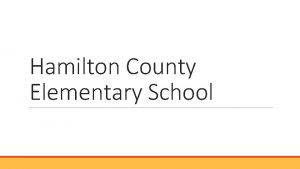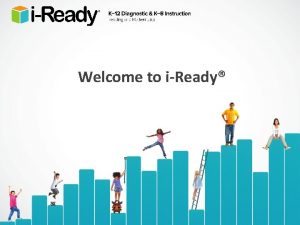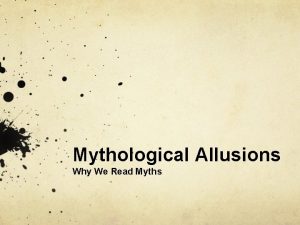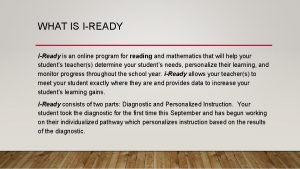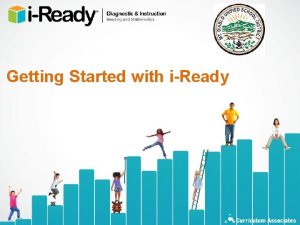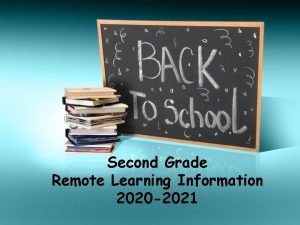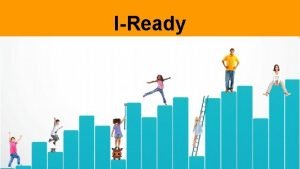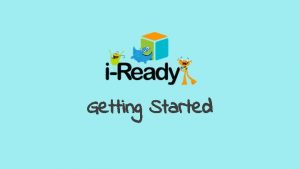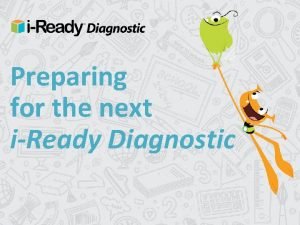WHAT IS IREADY iReady is an online program







- Slides: 7

WHAT IS I-READY i-Ready is an online program for reading and mathematics that will help your student’s teacher(s) determine your student’s needs, personalize their learning, and monitor progress throughout the school year. i-Ready allows your teacher(s) to meet your student exactly where they are and provides data to increase your student’s learning gains. i-Ready consists of two parts: Diagnostic and Personalized Instruction. Your student took the diagnostic for the first time this September and has begun working on their individualized pathway which personalizes instruction based on the results of the diagnostic.

WHAT IS THE DIAGNOSTIC? • The i-Ready Diagnostic is an adaptive assessment that adjusts its questions to suit your student’s needs. Each item a student sees is individualized based on their answer to the previous question. For example, a series of correct answers will result in slightly harder questions, while a series of incorrect answers will yield slightly easier questions.

WHAT DOES THE SCALE FROM THE DIAGNOSTIC MEAN? The scale scores that result from the Diagnostic measure all students on the same scale so you can see which K– 12 skills your students have mastered, regardless of their grade level. Student performance is measured on a scale of 100– 800, with students’ current score indicating that they have mastered skills up to that point and still need to work on the skills beyond that point.

THE DIAGNOSTIC COVERS THESE READING DOMAINS: • Phonological Awareness is the understanding that a spoken word is made up of different parts and that each of these parts makes a sound. • Phonics instruction teaches children how to connect the sounds they hear in spoken words to the letters they see in written words. • High-Frequency Words are the words that appear most often in what children read. • Vocabulary is the name for the words a student knows. The more words a student knows, the easier it is to understand what the student reads. • Comprehension: Literature describes a student’s ability to understand types of writing that are usually made up, or fictional. Stories are the literary texts that students read most often, but plays and poems are also examples of literary texts. • Comprehension: Informational Text describes a student’s ability to understand types of writing that are usually true. Books about science or history are examples of informational text, as are newspaper articles or magazine articles.

THE DIAGNOSTIC COVERS THESE MATH DOMAINS: • Number and Operations in Grades K– 8 refers to the mathematics skills often thought of as arithmetic, from reading and writing numbers to adding, subtracting, multiplying, and dividing different types of numbers. • Algebra and Algebraic Thinking in Grades K– 8 refers to mathematics skills related to seeing number patterns, understanding the meaning of addition, subtraction, multiplication, and division, and using symbols to write and solve equations including those used to solve word problems. • Measurement and Data in Grades K– 8 is a wide range of mathematics skills related to collecting, organizing, and interpreting numerical information, from telling time or using a ruler to measure the length of an object to using formulas to find volume or surface area. It also includes understanding tables and graphs. • Geometry in Grades K– 8 refers to a variety of skills related to analyzing two- and three-dimensional shapes. These include naming and classifying shapes using characteristics such as symmetry, number of sides, and angle measures, and in later grades, using congruence and similarity.

WHAT HAPPENS AFTER THE DIAGNOSTIC? • As soon as a student takes the diagnostic, it places them on their own personalized pathway. The teachers use these results to determine next steps in instruction. • i-Ready Personalized Instruction provides students with lessons based on their individual skill level and needs, so your student can learn at a pace that is just right for them. These lessons are fun and interactive to keep your student engaged as they learn.

IF YOU WANT TO LEARN MORE GO TO: i-Ready. Central. com/Family. Center/What-Is-i-Ready/.
